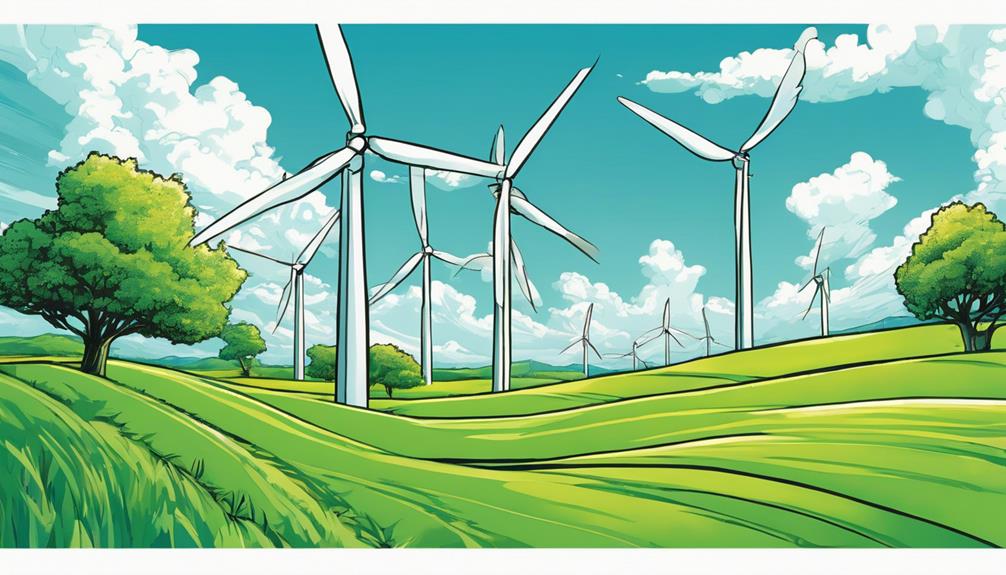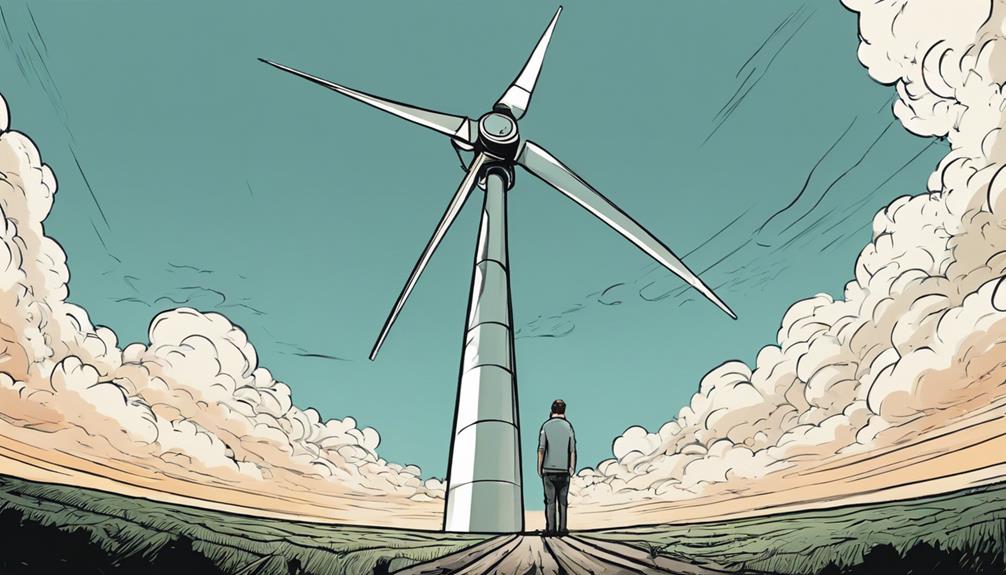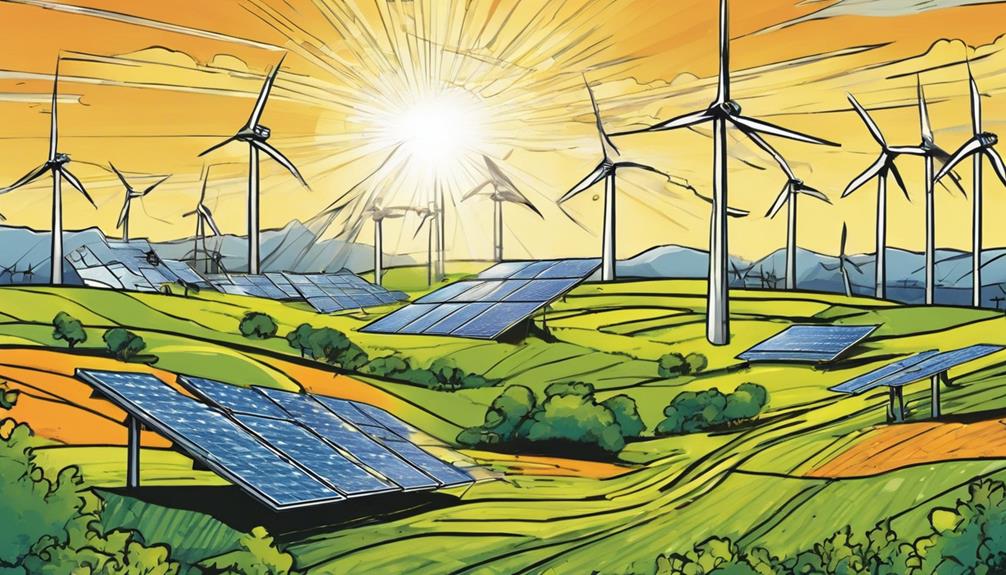When considering wind power for renewable energy, note the key variances between wind turbines and windmills. Windmills historically grind grain and move water, while wind turbines focus on generating electricity. Efficient blade design maximizes wind potential in both. Wind energy is transformed into mechanical and electrical power in turbines through rotation and generators. The evolution traces back to 9th-century Persia for windmills and late 19th-century for turbines. Their essential roles in supplying electricity, reducing emissions, and offsetting carbon footprints mark them as vital green energy sources. Understanding their differences can shed light on their importance in sustainable energy solutions.
Key Takeaways
- Wind turbines generate electricity, while windmills historically milled grain or pumped water.
- Blade design is crucial for efficiency in both wind turbines and windmills.
- Wind turbines focus on rotational power and generators for electricity.
- Wind energy from turbines is vital for sustainability and reducing greenhouse gas emissions.
- Historical evolution shows wind turbines have advanced significantly, with record-breaking blade sizes in 2022.
Windmill Functionality
Windmills utilize wind power to perform different mechanical functions such as milling grain and moving water. These iconic structures harness the energy of the wind to convert it into rotational power, which is then utilized to operate mechanisms for milling grains or moving water.
The efficiency of a windmill depends on its ability to capture the strength of the wind with its sails, spinning along a horizontal axis. This spinning movement is then transmitted through gears to operate the millstones for milling grain or the pump for raising water. The wind power is thus converted into mechanical energy, enabling the windmill to carry out important functions effectively.
Through the clever design of vertical windmills, historical uses have included not just milling grain but also moving water and even creating paper pulp. This showcases the adaptability and significance of windmills in using wind energy for various practical uses.
The intricate relationship between wind, rotational power, and mechanical parts highlights the creativity behind windmill functionality.
Wind Turbine Operation
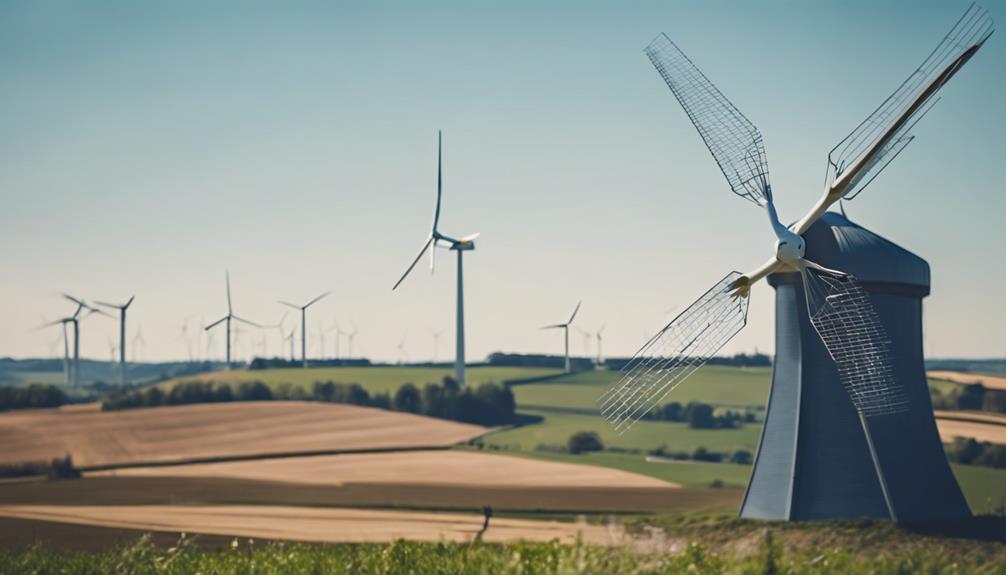
Wind turbine operation involves the efficiency of blade design, the mechanism for generating electricity, and the application of wind power.
The design of the blades impacts how effectively they capture wind energy, while the electricity generation mechanism transforms this energy into usable power.
Wind power application refers to how this generated electricity is utilized within the electrical grid.
Blade Design Efficiency
With longer blades, wind turbines significantly enhance their electricity generation efficiency, capturing more wind energy and increasing rotational speeds. This advancement in blade design efficiency is essential for maximizing the potential of wind power.
Some key points to take into account in blade design efficiency are:
- Length Matters: Modern wind turbines feature blades over 100 meters long, allowing for better wind energy capture and improved electricity generation capabilities.
- Record-breaking Innovation: Siemens Gamesa achieved a milestone in 2022 by introducing 108-meter blades, showcasing the continuous progress in enhancing turbine efficiency through advanced designs.
- Tower Height Optimization: Taller wind turbine towers are designed to accommodate longer blades, optimizing wind energy capture and ultimately boosting electricity production.
- Offshore Advantage: Offshore wind turbines leverage taller structures and longer blades to harness stronger and more consistent wind speeds, leading to increased efficiency in electricity generation.
These factors highlight the importance of blade design efficiency in driving the effectiveness of wind turbines for sustainable energy production.
Electricity Generation Mechanism
Lengthy blades on wind turbines aid in the conversion of wind's kinetic energy into rotational energy to efficiently generate electricity.
When the wind causes the blades to rotate, the rotor shaft connected to the blades also spins. This spinning motion powers a generator inside the turbine.
The generator is equipped with wire conductors that interact with magnetic fields, resulting in the creation of electricity through electromagnetic induction.
The rotational energy from the wind is then converted into electrical energy that can be utilized for various purposes.
The electricity produced by wind turbines is subsequently transmitted through power lines to residences, establishments, and the electrical grid, offering a sustainable energy source.
Through harnessing the wind's power, wind turbines play a crucial role in the global transition towards renewable energy sources, aiding in a cleaner and more eco-friendly method of electricity generation.
Wind Power Application
To understand how wind turbines operate in generating electricity, it's essential to grasp the mechanism by which wind energy is efficiently converted into electrical power.
Here are some key points to keep in mind regarding wind power application:
- Wind turbines generate electricity by transforming wind energy into rotational force through the blades connected to a camshaft passing wire through a magnetic field.
- Unlike windmills, which were traditionally used to grind grain or pump water, turbines usually harness wind power for generating electricity.
- The conversion of kinetic energy from the wind into mechanical energy and then into electrical energy is the primary function of wind turbines in electricity generation.
- Wind turbines play a vital role in renewable energy production by effectively converting rotational energy from the wind into usable electrical power for various applications.
Historical Evolution
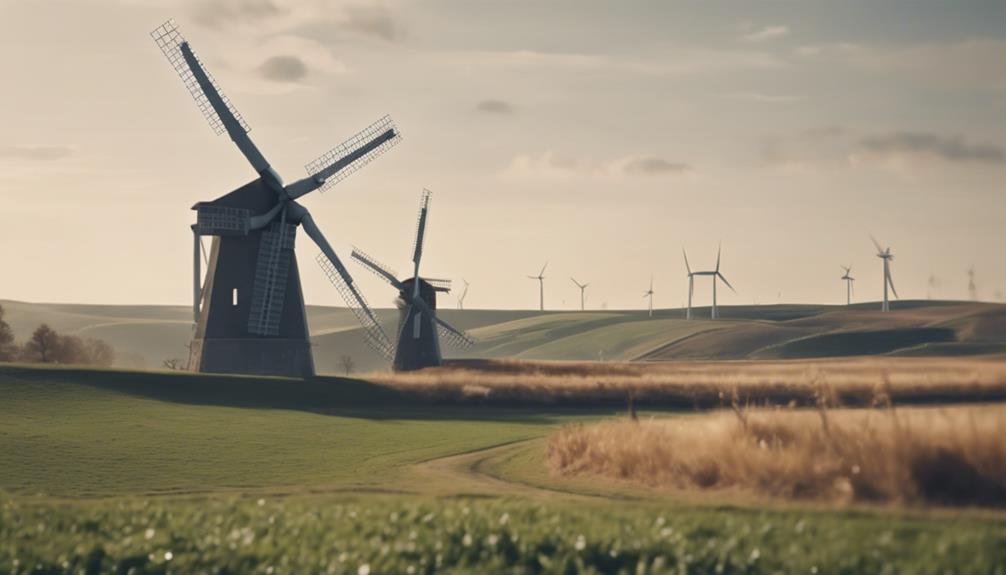
You'll discover the historical journey of wind energy from its humble beginnings grinding grain in the 9th century to the sophisticated electricity generation of modern wind turbines.
As you explore the evolution, pay attention to the technological advancements that have propelled wind energy forward, making it a key player in the renewable energy sector.
From practical applications in farming to providing a substantial portion of a country's electricity, the historical evolution of wind turbines and windmills is a fascinating tapestry of innovation and progress.
Historical Origins
Windmills originated in the 9th century in Persia, serving various tasks like grinding grain, while the first electricity-generating wind turbine traces back to 1887 in Denmark.
Spread of Windmills:
Windmills spread through Eurasia with Islam, reaching Europe and North America by the 17th century. They facilitated farming in regions like the American Great Plains.
Evolution of Wind Turbines:
Wind turbines evolved to combat challenges against coal and oil in North America. Denmark had 2,500 wind turbines by 1900.
Blade Length Advancements:
Since 2000, wind turbine blade lengths have increased. Siemens Gamesa set a record with 108-meter blades in 2022.
Utilization Purposes:
Historical windmills were used for grinding grain, pumping water, and paper pulp production. In contrast, modern wind turbines are utilized in various power plants for electricity generation.
Technological Advancements
Wind turbines have undergone significant historical evolution in design and efficiency, with advancements in blade length and tower height contributing to increased electricity generation capabilities.
The history of wind energy technology dates back to the late 19th century, with Denmark leading the way in widespread turbine use. The design efficiency of wind turbines has continuously improved, with longer blades being a key factor in enhancing electricity generation.
The first electricity-generating wind turbine marked a significant milestone in 1887, paving the way for further technological advancements. In recent years, there's been a notable increase in wind turbine blade lengths, exemplified by Siemens Gamesa's record-setting 108-meter blades in 2022.
Offshore wind turbines have also seen substantial progress, becoming taller and more efficient in harnessing wind energy for electricity generation. These technological advancements highlight the continuous innovation in wind turbine design, aiming to maximize electricity generation capabilities for a sustainable future.
Practical Applications
How have historical advancements in practical applications of wind energy shaped modern-day renewable energy solutions?
Windmills have served pivotal roles in history, from grinding grain to pumping water, while wind turbines have revolutionized the generation of electricity.
Here are key points differentiating the practical applications of wind turbines and windmills:
- Windmills: Initially used to mill grain and pump water, windmills have been integral to agricultural and industrial tasks for over a millennium.
- Wind Turbines: Introduced in the late 19th century, wind turbines have evolved to efficiently generate electricity from wind energy, showcasing significant technological advancements.
- Mechanical Power: Windmills primarily provided mechanical power for specific tasks, whereas wind turbines focus on electricity generation for broader applications.
- Renewable Energy Impact: While windmills historically aided in localized functions, wind turbines now play an essential role in providing a substantial portion of Denmark's electricity, highlighting the difference in renewable energy impacts between the two technologies.
Technological Advancements
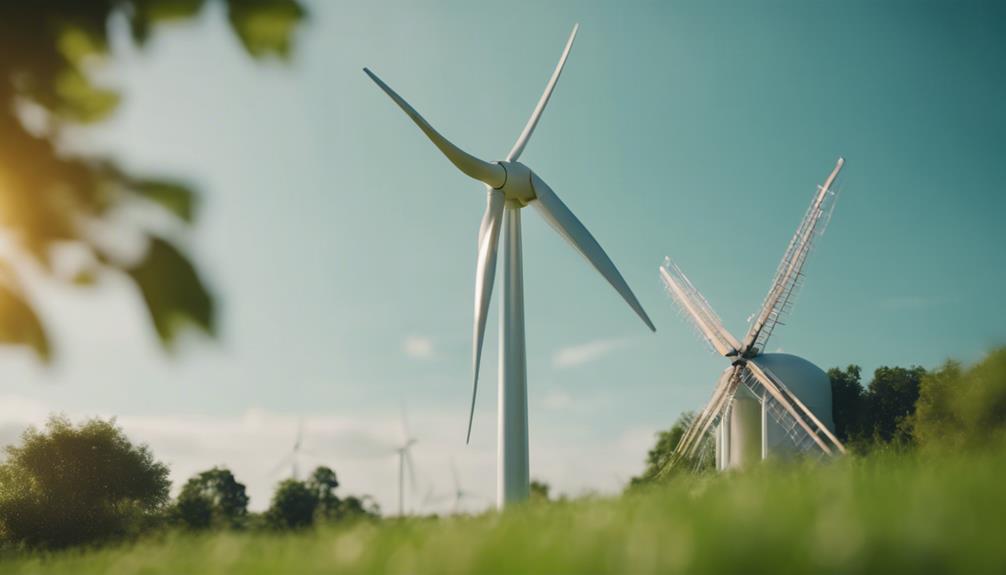
Recent technological advancements in the field of wind energy have revolutionized the efficiency and performance of wind turbines. Wind turbine blades have increased in length, with Siemens Gamesa achieving a record of 108-meter blades in 2022. These longer blades, coupled with taller towers, enhance electricity generation efficiency by capturing more energy from the wind.
Offshore wind turbines, which are taller and more efficient than their onshore counterparts, are at the forefront of harnessing wind energy. The continuous progress in wind turbine design and technology has resulted in improved performance and higher energy output levels.
These innovations aren't only driving the growth of wind energy technologies but also making wind farms more productive and sustainable sources of electric power. As advancements continue, the future looks promising for the renewable energy sector, with wind turbines playing an essential role in the shift towards cleaner and greener energy sources.
Practical Applications
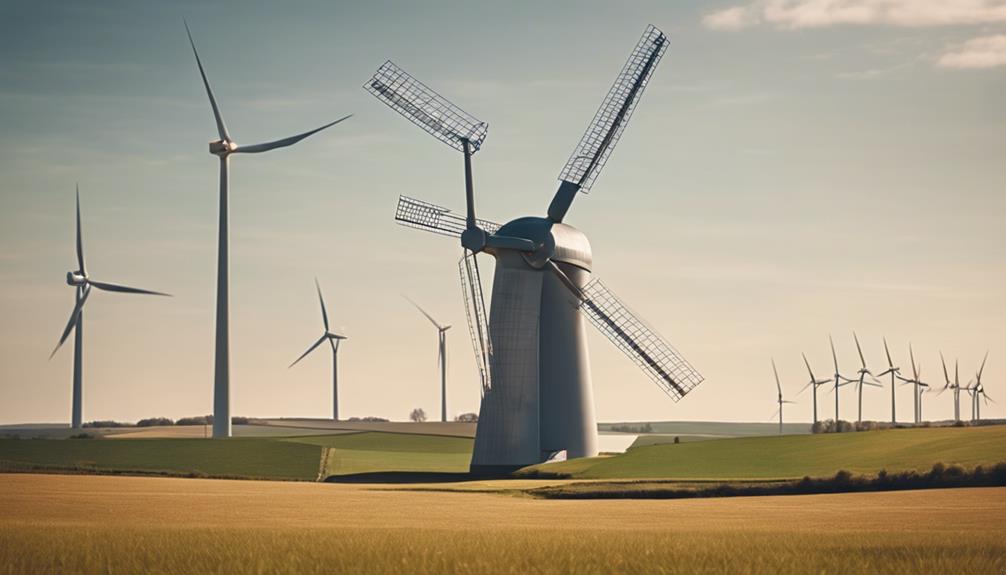
Practical uses of wind energy encompass a diverse range of applications, from providing electricity to rural areas to powering large-scale urban grids. Here are some key practical applications to bear in mind:
- Electricity Generation:
Wind turbines play an essential role in providing electricity to remote locations and urban grids, contributing significantly to renewable energy sources.
- Water Pumping:
Windmills are still utilized in rural areas for water pumping, showcasing a traditional yet effective application of wind energy.
- Historical Significance:
Ancient windmills like those in Nashtifan, Iran, and projects like the Africa Windmill Project demonstrate the long-standing practical uses of wind energy in various cultures.
- Scalability:
Wind energy is versatile and scalable, with applications ranging from large-scale power plants to distributed wind resources for individual customers, catering to a wide array of energy needs efficiently.
Further Exploration
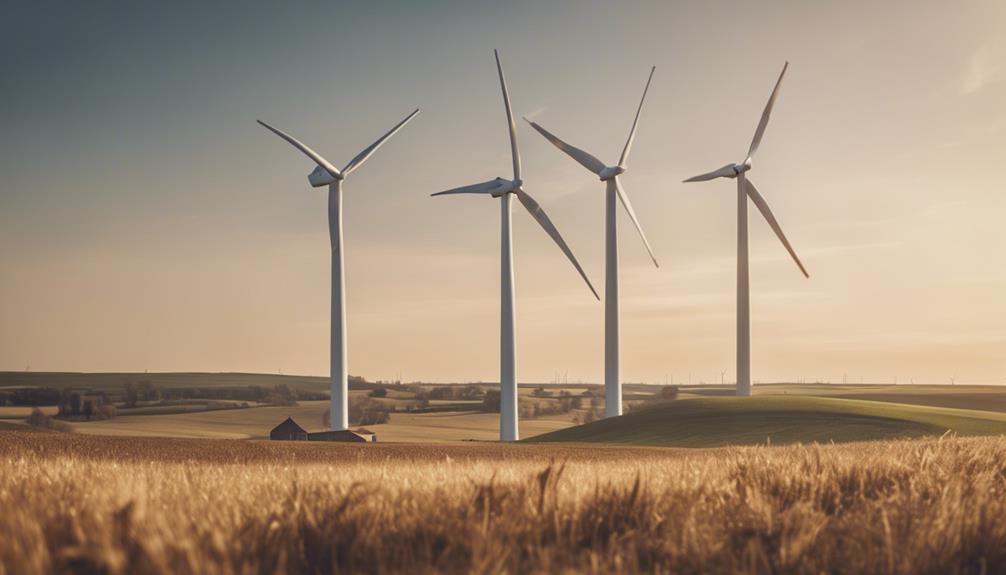
Exploring the advancements in wind energy technologies reveals the continuous innovation in harnessing renewable resources for sustainable energy solutions. Wind turbines have revolutionized the landscape of electricity generation, converting wind's kinetic energy into power efficiently.
Meanwhile, windmills, historically known for tasks like water pumping and grain grinding, represent the traditional use of wind energy for mechanical power. The evolution from windmills to modern wind turbines highlights the shift towards renewable energy sources to combat climate change and reduce reliance on fossil fuels.
With taller towers and longer blades, wind turbines have notably improved their electricity generation efficiency over time. Innovations like Siemens Gamesa's 108-meter blades exemplify the progress in maximizing power output.
Both windmills and wind turbines play essential roles in harnessing wind energy for practical applications, displaying the versatility of wind energy from historical uses to modern electricity generation. Understanding these differences offers valuable insights into the progression of wind energy technologies towards sustainable solutions.
Environmental Impact and Sustainability
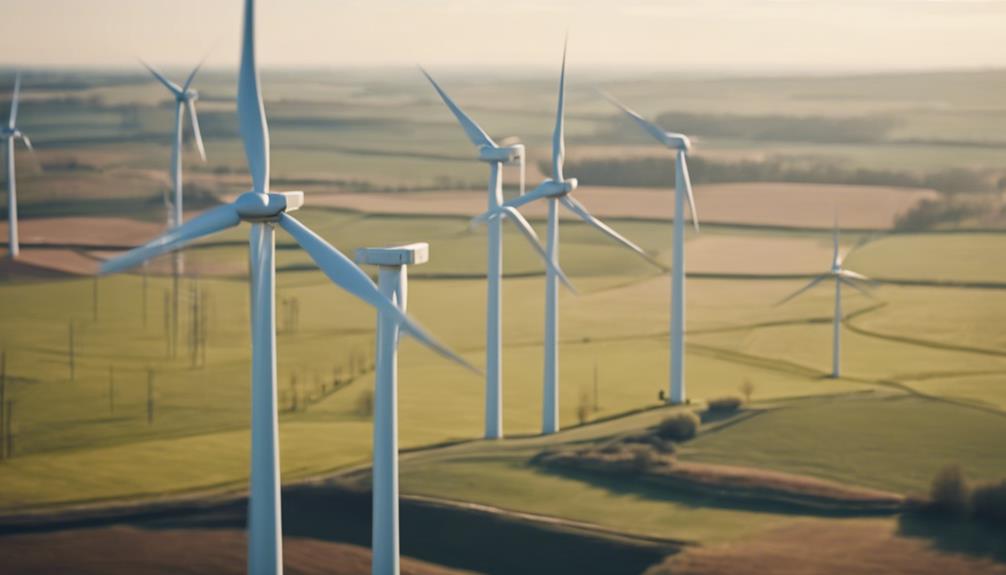
Wind turbines and windmills both play significant roles in reducing greenhouse gas emissions and promoting sustainability through their contributions to renewable energy sources.
When it comes to environmental impact and sustainability:
- Wind turbines reduce greenhouse gas emissions by generating clean electricity from wind energy, aiding in combating climate change.
- Wind energy contributes to sustainability goals by providing a renewable and eco-friendly power source, reducing the reliance on fossil fuels.
- Wind projects offset their carbon footprint within six months of operation, showcasing their environmental benefits and commitment to sustainability.
- Both wind turbines and windmills play an essential role in promoting renewable energy, which is renewable, abundant, and essential in the fight against climate change through sustainable energy practices.
Frequently Asked Questions
What Is the Difference Between Windmills and Wind Turbines?
Windmills convert wind energy for tasks like grinding grain, while wind turbines generate electricity. Windmills have vertical blades and produce mechanical power, whereas wind turbines have horizontal blades and generate electricity for renewable energy systems efficiently.
How Are Windmills Different From Wind Turbines Responses?
When considering how windmills differ from wind turbines, understanding their distinct functions is crucial. Windmills produce mechanical power for physical tasks, whereas wind turbines efficiently harness wind energy to generate electricity, serving modern sustainability goals.
What Advantages Does the Wind Turbine Have as a Renewable Source of Energy?
You'll find wind turbines offering advantages as a renewable energy source. With their efficient electricity conversion, large power generation, diverse installation options, and small footprint, they're ideal for urban and remote areas, proving cost-effective and efficient.
What Are the Three Types of Wind Turbines?
Three types of wind turbines are horizontal-axis wind turbines (HAWT), vertical-axis wind turbines (VAWT), and hybrid wind turbines. Each type has unique design features and applications, contributing to the diversity of wind energy generation.
How Do Wind Turbines Revolutionize Renewable Energy Compared to Windmills?
Wind turbines and renewable energy have revolutionized the way we harness wind power. Unlike traditional windmills, modern turbines are designed to capture more energy from the wind, generating electricity on a larger scale. This advancement in technology has made wind turbines a more efficient and sustainable option for renewable energy.
Conclusion
As you reflect on the differences between wind turbines and windmills, remember that these structures represent more than just renewable energy sources. They symbolize innovation, progress, and the continuous pursuit of a sustainable future.
Embrace the evolution of technology and the potential for positive environmental impact that these advancements bring. Keep exploring, learning, and supporting the growth of renewable energy solutions for a better tomorrow.


